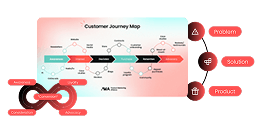In product marketing, discussions often revolve around positioning, enablement, go-to-market strategies, and more. However, there's less focus on how the customer relationship post-conversion can – and should – be continuously monitored to ensure your product's ongoing success.
This is where the product marketing team can collaborate with the customer marketing team to develop initiatives that keep your product and company present throughout the entire customer journey, engaging users at various touchpoints and building meaningful relationships.
I understand that not every company has a dedicated customer marketing function. This discipline is still in its early stages in some countries and regions (I'm Brazilian, and here, I see this area at an initial maturity level, similar to where product marketing was three or four years ago). Nevertheless, it's a discipline with significant potential and is poised for growth in the coming years. Keep an eye on it 😉.
In this article, I'll explore how product marketing and customer marketing intersect, collaborate, and amplify each other's efforts to make a difference in your company!
First things first: What is customer marketing?
Customer marketing focuses on actions and initiatives directed at your existing customers. Its goal is to be present throughout your customer's journey within your product, from product education, adoption, and engagement to retention, advocacy, expansion, and referrals.
The primary value generated by this area lies in delivering communications that users need, want, or enjoy, coupled with promoting relevant, intentional, and personalized experiences.
This combination directly impacts strategic metrics and key business objectives such as reducing churn and increasing retention, adoption, engagement, loyalty, and brand referrals.
In essence, the area plays a fundamental role in transforming occasional customers into recurring ones and loyal customers into brand advocates.
Ultimately, this generated value translates simply into placing your customers at the center of your strategy, making them feel valued and appreciated.
The business impact of strong customer marketing
It's well-known that acquiring new customers is significantly more expensive than retaining existing ones. And I don’t need to tell you that competition is intensifying. Markets are increasingly saturated, and companies strive to stand out amidst the noise.
In this context, retaining customers isn't just a ticket to growth; it's essential. If your bucket is constantly leaking, you'll never upgrade to a larger bucket because you're not retaining enough to ensure growth. In other words, if you can't retain your customers, you won't scale your customer base's growth.
Furthermore, delivering an exceptional and personalized experience provides a competitive advantage. A company can simultaneously retain existing customers and, ideally, attract potential ones, which is excellent news for revenue.
Indicators like reduced churn and increased LTV demonstrate that working with your customer base is more cost-effective. Additionally, the return on investment (ROI) for customer marketing activities tends to be much higher than for more general and less targeted marketing efforts.
Let's imagine the following scenario:
User Frank acquired your service/system today and began onboarding. He's highly engaged and enthusiastic about the new product.
As he receives support during this introduction, being educated about the product and deriving value, he realizes that his pain points are being addressed, and the objective that led him to your solution is being met. Consequently, he decides that your product was what he needed and chooses to continue and renew your service.
He stays and increasingly uses your solution daily. He becomes not only engaged but also loyal to your solution. His own pain points and needs evolve, transforming and giving rise to new ones. Then he decides it's time to evolve and expand/contract new solutions you offer that may be relevant in this new context of his life.
At this point, he not only uses and greatly appreciates your solution but also recommends it to his colleagues.
A fairy tale scenario? Perhaps! 😅
But it also illustrates the significant impact that the area – along with a well-structured retention, product experience, and expansion strategy – can have on the company's key business and revenue indicators.
Customer marketing impacts the business in various ways, including:
📥 Adoption: Helping users understand a product's value (first-time value). If onboarding is personalized, frictionless, and engaging, you're setting your customers up for success within the product.
🌀 Renewal and retention: Existing customers are the primary focus of a customer marketing professional – providing them with a memorable and engaging experience that genuinely enhances their lives will encourage them to return. As a result, they'll remain loyal and continue purchasing from you as their needs and desires are met.
🤑 Increasing sales (upgrade, upsell, cross-sell): Loyal customers are much more likely to fully engage with your business and brand, purchasing new products and services your company offers. They require less convincing to buy due to the established trust in your brand and business.
🤝 Building relationships: Strong customer relationships help drive loyalty and engagement. This translates into renewals, cross-sales, and upsells, leading to increased profits for your business. Relationships are also crucial for creating active brand advocates.
🗣️ Generating reviews, case studies, and testimonials: As third-party validation, these serve as social proof for your brand, products, and services. Testimonials are effective because hearing about your product's benefits from a real customer is more credible and authentic than any marketing content or advertisement you've created.
⭐ Accelerating advocacy and referrals: With all these factors combined, your customers will promote and amplify your brand through their own voices to their audiences and peers, attracting new customers via social media and other channels. How customers and advocates talk about and represent your company is a differentiating factor.
Where does product marketing fit into this equation?
In the context of product marketing, there's still limited discussion about the post-conversion stage. Most discussions and content focus heavily on positioning, enablement, and go-to-market strategies.
This might lead us to believe that the product marketing team's responsibilities end with the launch of features and products, with little thought given to how this team can contribute to building relationships and continuous adoption in the long term – and this is precisely where customer marketing can become an important ally.
If we consider that product marketing also involves delivering clear messages, facilitating the adoption and use of features, and ensuring the product's positioning is present throughout the customer journey, then we're talking about a role that goes beyond activation and moves toward retention. The customer marketing team can be an extension of product marketing's efforts. Together, they can form a powerful duo!
5 key areas of collaboration between PMM and customer marketing
Currently, I coordinate both product marketing and customer marketing initiatives. Within my team, I recognize five main overlapping areas that are not only interesting but necessary to strengthen our users' evolution within the product. Let’s take a look.
1. Customer expertise
For me, the primary intersection between product marketing and customer marketing is the user. Both focus on the user, understanding their needs and interests. After all, product marketing and customer marketing wouldn't exist without users.
2. Personalization
While the strategy for actions and communications falls under the customer marketing team's scope, constant and regular exchanges between these two teams allow for more tailor-made communications, considering use cases, jobs to be done, and user needs that the PMM has already developed and integrated into the product and business.
3. Onboarding and adoption
PMMs play a crucial role in ensuring the adoption of the product's core features and GTM adoption metrics. The customer marketing team collaborates to support PMMs in creating communications and strategies that drive this adoption.
Working together, PMMs can identify adoption pain points and raise concerns with the product team to help customers and validate positioning, messaging, and market analysis.
4. Usage behavior
Customer marketing is primarily responsible for mapping and understanding customer usage behavior throughout our solution. By joining forces with the product marketing and product teams, we gain a broader view of the experience, considering different personas and use cases.
We can combine communication with in-product experience to deliver value and help our users progress within the solution, identifying their next steps and introducing them to the next solution they might be interested in, thus nurturing more loyal customers.
5. Customer insights
Connected to the previous two points, product marketing collaborates with customer marketing to gather valuable user insights about the product, both pre- and post-launch.
Customers may struggle to understand a feature's benefits or how to use it correctly. This information allows PMMs to raise concerns with the product team and create assets to assist customers. This is a typical case where analyzing feedback or usage behavior can inform and refine a competitive intelligence strategy, messaging, and positioning.
In summary, you need both product marketing and customer marketing to scale effectively. They fuel a growth engine that attracts new, qualified customers and keeps your users engaged and evolving with the product.
Practical examples of this collaboration
- Adoption campaigns: Utilizing feature usage data for campaigns focused on product adoption.
- Post-launch educational content: Creating content and educational strategies for feature launches targeting the current customer base.
- Building advocacy programs: Developing product advocate programs based on usage, NPS, and satisfaction.
- Collecting qualitative feedback: Facilitating conversations with customers to understand perceptions and identify product improvement opportunities.
Shared metrics: Measuring joint impact
Even when collaborative work flows smoothly, it's essential to establish some guardrails and guidelines for each team.
When it comes to metrics, we have some clear divisions:
- Product marketing focuses more on the adoption of the product's core features, daily/monthly active users, and GTM adoption metrics.
- Customer marketing concentrates on onboarding dynamics, education, and ensuring users have all the necessary information to be introduced to the product with a good experience and start using it.
Additionally:
- Product marketing looks at the company's revenue goals, supporting the generation of truly qualified SQLs within our ICP, as well as revenue targets for new products.
- Customer marketing focuses more on monetization pillars generated by our user base, such as add-on conversions, upgrades, upsells, and cross-sells.
Furthermore:
- Product marketing considers conversion metrics like win rates, sales confidence, and empowering the team with new assets.
- Customer marketing examines churn/retention metrics and solution referral rates.
Some metrics that can help measure this collaborative work include:
- Feature adoption
- Engagement with post-launch campaigns
- Customer retention
- NPS (Net Promoter Score)
- Upsell and cross-sell in existing accounts
- Participation in advocacy programs
Conclusion
The customer marketing team can be a great ally to the product marketing team. When we think about the customer lifecycle and how the relationship doesn't end at the sale, we can expand the possibilities for action, positioning, and value delivery.
Having both areas structured and strategically positioned within your company can be the game-changer you need to increase customer retention, loyalty, and overall company growth.
Customer marketing is about nurturing, engaging, and strengthening relationships – transforming new customers into recurring and loyal users, and loyal customers into brand advocates. By prioritizing experience and long-term relationship building, this discipline becomes essential for sustainable growth. And the product marketing team can – and should – play an active role in making that happen.


















 Follow us on LinkedIn
Follow us on LinkedIn




.svg)
Start the conversation
Become a member of Product Marketing Alliance to start commenting.
Sign up now